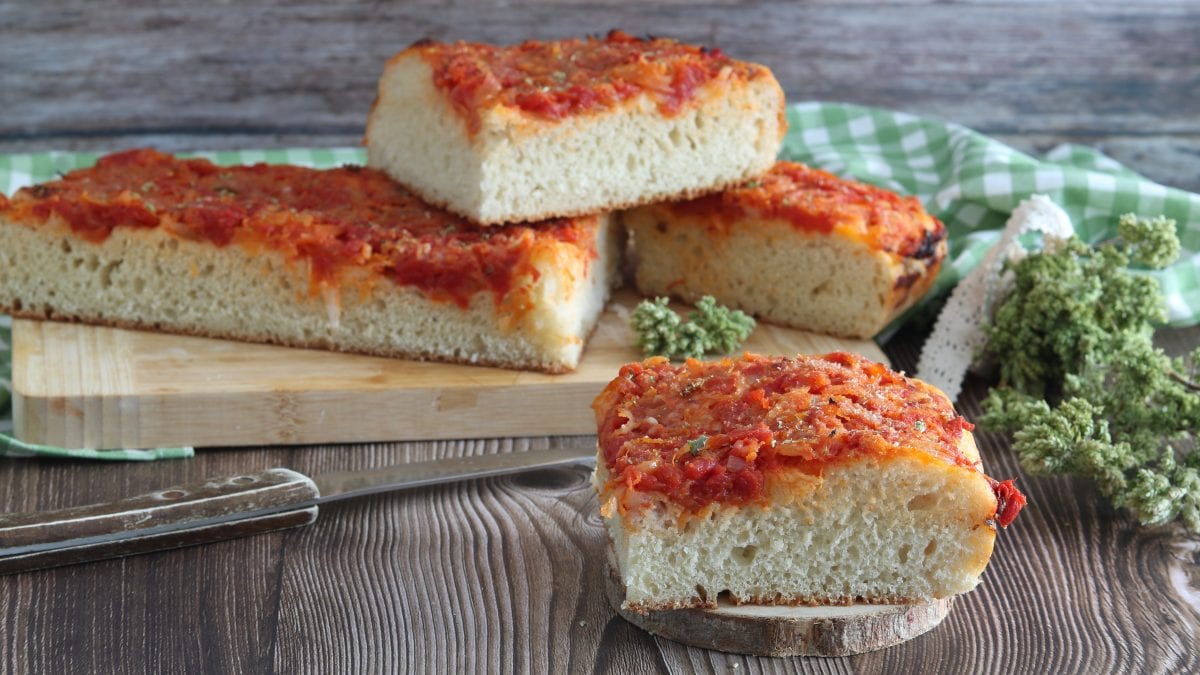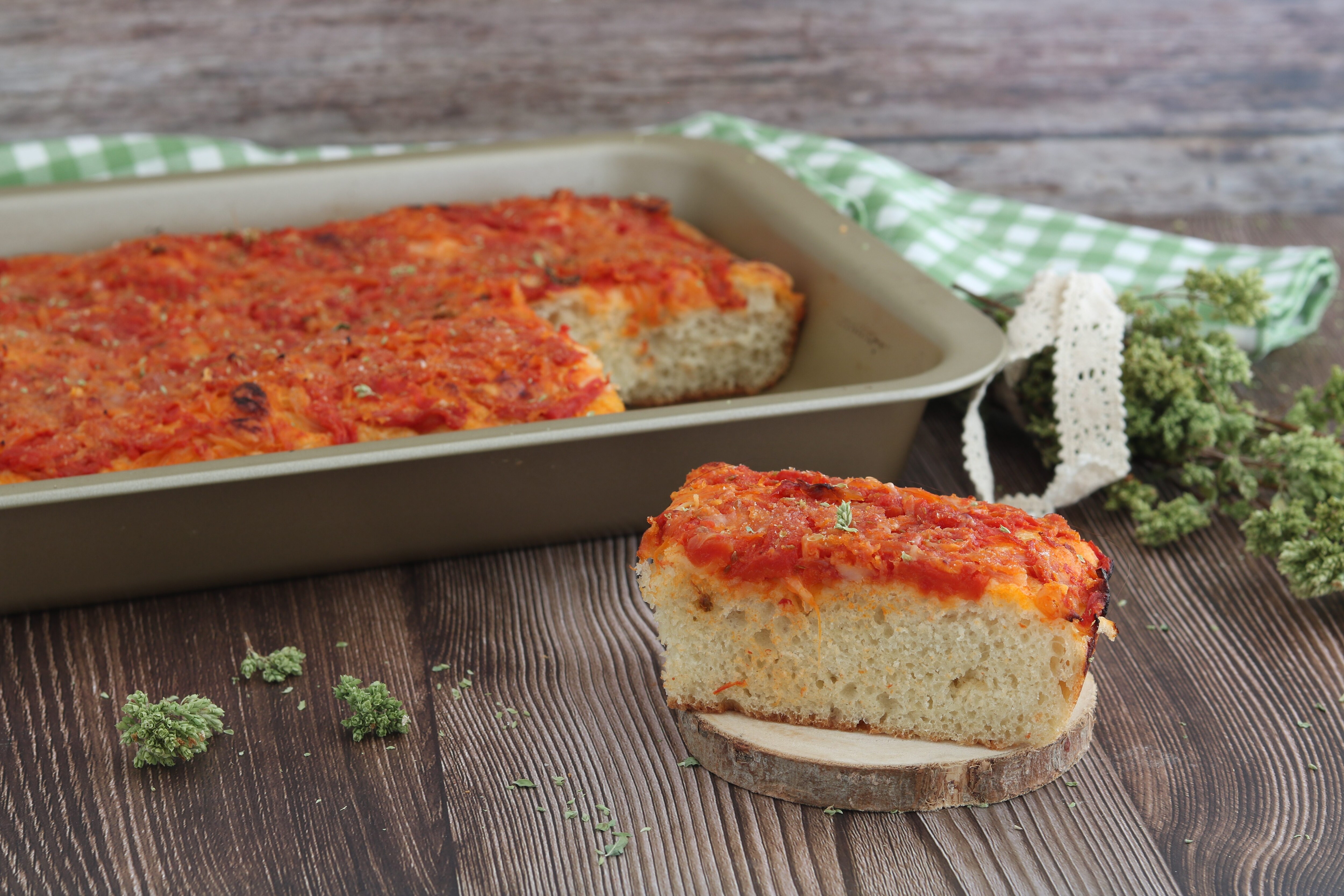Sfincione: the authentic, tasty recipe for the popular Sicilian pizza

The sfincione (pronounced sfihn-chao-niy) is an easy, tasty thick-crust pizza which is typical of Sicilian cuisine (in particular of Palermo). Usually enjoyed during Christmas holidays, it is like a high, soft, spongy focaccia bread with crispy edges and bottom layer. The authentic sfincione is topped with a tomato and onion sauce, local caciocallo cheese (hard Sicilian sheep's milk cheese), dried oregano, anchovies in oil and breadcrumbs.
Tasty and fragrant, the sfincione is one of the most popular Sicilian street foods. It is fluffy like a sponge – the Italian name sfincione derives from the Latin term spongia, that means "sponge" as it is very soft.
With uncertain origins, the Sicilian sfincione seems to have been prepared for the first time by the nuns of the convent of San Vito, around 1700.
For the best results, it is important to carefully follow the leavening times; first without and then with the seasoning. The sauce will be cooked slowly and for a long time, until it is well reduced and the onions completely flaked.
The sfincione must be high and soft, so the quantities indicated in the recipe use a 24 × 32 centimeters pan, or slightly smaller, but never larger, otherwise the Sicilian sfincione will be too thin and will tend to dry out too much during cooking. So let’s find out how to make the Sicilian sfincione by following our recipe step by step.
Sfincione vs Regular Pizza
Sicilian sfincione should be considered more as a thick and fluffy focaccia bread instead of a traditional pizza. So, it is closer to the US pizza than a Neapolitan one.
In fact, the sfincione has a crispy bordered crust as it is made in a oven-safe pan. Moreover, the sauce should be spread right to the edge instead of leaving some space on the crust like classic pizza.
Tips for making Sfincione Christmas Sicilian Pizza
If you can't find caciocavallo cheese, you can also use pecorino or parmesan cheese.
Like all traditional recipes, of course, there are numerous variants, like the Bagheria variant, dressed in white with tuma cheese, ricotta cheese and onions.
If you prefer a more delicate taste, you can use a less aged caciocavallo cheese.
Don't use too much salt in the sauce as both anchovies and caciocavallo cheese are quite salty.
Use a scale for the best results.
How to store Sicilian Sfincione
The authentic sfincione can be stored for 2 days in the refrigerator or in a dry place, wrapped in food paper. You can enjoy it cold or, if you prefer, heat it for a few minutes in the oven; it will be like freshly baked.
How to make the Sfincione

Combine the flour and the milled durum wheat semolina in a bowl.
Combine the flour and the milled durum wheat semolina in a bowl.

Mix the flours.
Mix the flours.

Crumble the fresh brewer's yeast.
Crumble the fresh brewer's yeast.

Pour in the lukewarm water.
Pour in the lukewarm water.

Stir with a spoon to incorporate it.
Stir with a spoon to incorporate it.

Add the extra virgin olive oil and then the salt.
Add the extra virgin olive oil and then the salt.

Knead quickly with your hands.
Knead quickly with your hands.

Turn the dough over onto a floured work surface.
Turn the dough over onto a floured work surface.

Work the dough by spreading it with your hands and then practicing some folds.
Work the dough by spreading it with your hands and then practicing some folds.

When the dough is well strung, form a smooth and homogeneous ball.
When the dough is well strung, form a smooth and homogeneous ball.

Transfer the ball to a bowl and grease the surface with a drizzle of extra virgin olive oil.
Transfer the ball to a bowl and grease the surface with a drizzle of extra virgin olive oil.

Cover with cling film and let rest in the oven off, but with the light on, until the initial volume is doubled; it will take about 2 hours.
Cover with cling film and let rest in the oven off, but with the light on, until the initial volume is doubled; it will take about 2 hours.

Meanwhile, prepare the sauce; peel the onions and cut them into thin slices.
Meanwhile, prepare the sauce; peel the onions and cut them into thin slices.

Chop the peeled tomatoes or cut them into strips. If you like, you can also blend them.
Chop the peeled tomatoes or cut them into strips. If you like, you can also blend them.

In a saucepan pour the extra virgin olive oil.
In a saucepan pour the extra virgin olive oil.

Add the anchovy fillets, well drained from the conservation oil.
Add the anchovy fillets, well drained from the conservation oil.

Add the onions and cook over low heat until they are well wilted.
Add the onions and cook over low heat until they are well wilted.

Pour the tomatoes, season with salt and cover with the lid. Cook over low heat for about an hour and a half. If necessary, add a ladle of hot water while cooking. Turn off and let it cool.
Pour the tomatoes, season with salt and cover with the lid. Cook over low heat for about an hour and a half. If necessary, add a ladle of hot water while cooking. Turn off and let it cool.

Grease a 24 × 32 centimeters pan.
Grease a 24 × 32 centimeters pan.

Take back the leavened dough and turn it over directly into the pan.
Take back the leavened dough and turn it over directly into the pan.

With your hands lightly greased with oil, gently roll out the dough without breaking the bubbles.
With your hands lightly greased with oil, gently roll out the dough without breaking the bubbles.

Arrange the anchovy fillets.
Arrange the anchovy fillets.

Cover with cling film and let rise for about thirty minutes.
Cover with cling film and let rise for about thirty minutes.

Cut half caciocavallo cheese into cubes.
Cut half caciocavallo cheese into cubes.

Grate the second half.
Grate the second half.

After the leavening time, take back the dough and spread the pieces of cheese on the surface.
After the leavening time, take back the dough and spread the pieces of cheese on the surface.

Sprinkle with the onion sauce.
Sprinkle with the onion sauce.

Add the grated caciocavallo cheese.
Add the grated caciocavallo cheese.

Continue with the breadcrumbs.
Continue with the breadcrumbs.

Finally, flavor with dried oregano.
Finally, flavor with dried oregano.

Let the dough rest for about fifteen minutes, or until not it will be well swollen. Bake in a static oven at 250° C (482° F) for ten minutes, placing the pan on the first level, the lowest one, then move it to the second level, the intermediate one, and continue cooking for another ten minutes.
Let the dough rest for about fifteen minutes, or until not it will be well swollen. Bake in a static oven at 250° C (482° F) for ten minutes, placing the pan on the first level, the lowest one, then move it to the second level, the intermediate one, and continue cooking for another ten minutes.

When the edges are slightly golden, take the sfincione out of the oven and let it rest for a few minutes. Cut into squares and serve.
When the edges are slightly golden, take the sfincione out of the oven and let it rest for a few minutes. Cut into squares and serve.




